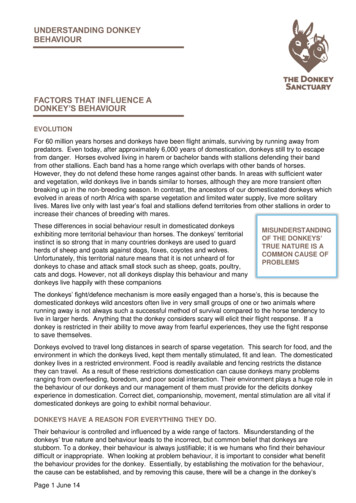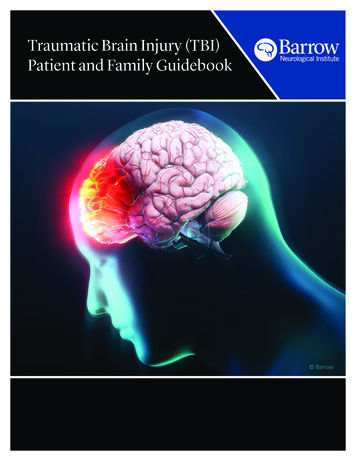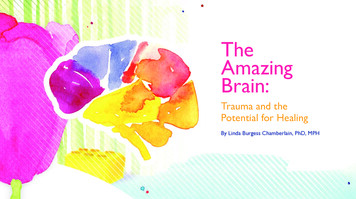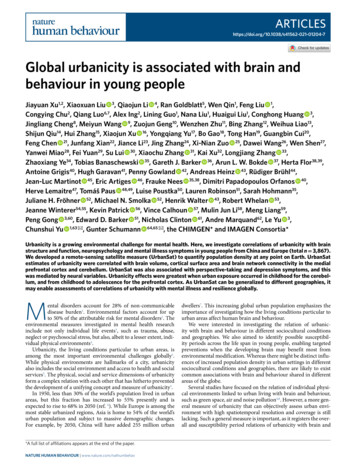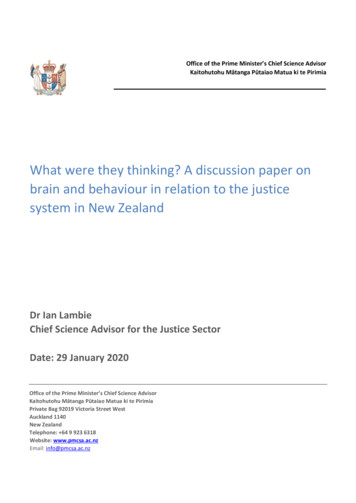
Transcription
Office of the Prime Minister’s Chief Science AdvisorKaitohutohu Mātanga Pūtaiao Matua ki te PirimiaWhat were they thinking? A discussion paper onbrain and behaviour in relation to the justicesystem in New ZealandDr Ian LambieChief Science Advisor for the Justice SectorDate: 29 January 2020Office of the Prime Minister’s Chief Science AdvisorKaitohutohu Mātanga Pūtaiao Matua ki te PirimiaPrivate Bag 92019 Victoria Street WestAuckland 1140New ZealandTelephone: 64 9 923 6318Website: www.pmcsa.ac.nzEmail: info@pmcsa.ac.nz
ForewordLike all good trilogies, Ian Lambie’s series of three discussion papers exploring factors thathave led Aotearoa New Zealand to have a high incarceration rate has turned out to have afourth part. The first three reports are available on our website. Using evidence to build abetter justice system: The challenge of rising prison costs, covered factors related toincarceration rates and the costs of incarceration. It’s never too early, never too late: Adiscussion paper on preventing youth offending in New Zealand explored factors particularlyrelevant to youth offenders (up to age 25 years). The third report Every 4 minutes: Adiscussion paper on preventing family violence in New Zealand highlighted how familyviolence and child maltreatment are risk factors for future offending, and how we, as a society, need to domore to prevent the multiple causes and consequences of violence. This latest discussion paper touches onanother theme evident in exploring the criminal-justice system: the high rates of concerning brain andbehavioural issues associated with those within the system. Like the last report, it is aimed at a generalaudience and hopes to raise the level and amount of debate and inspire action, by presenting the evidence ofhow we can do better in our criminal-justice system.Ian presents a strong evidence base that throughout the system, those suffering brain injuries are overrepresented as both victims and perpetrators. He then explores the question of what this means for justice,citing example after example of those whose behaviour is misinterpreted as that of ‘the difficult and theguilty’, when in fact they are confused, afraid, and unable (not unwilling) to correctly answer the question thatmay cost them their freedom. Ian argues that the high profile case of Teina Pora, whose Fetal AlcoholSpectrum Disorder led him to confess to a crime he did not commit, is the tip of an iceberg. The title of thereport “What were they thinking?” captures the enormous challenge faced by those in the criminal-justicesystem in deciphering the difference between those who won’t cooperate, and those who simply can’t.As with the first three reports, early diagnosis and intervention is where the evidence points us to solutions.Individual diagnoses will be complex, but this should not prevent action, which can start very simple andshould start very soon. Precise diagnosis may not be possible, but targeted, practical support based onobserved difficulties could be.This report is endorsed by my Office on behalf of the Forum of Chief Science Advisors.Professor Juliet Gerrard FRSNZ, HonFRSCDr Ian Lambie is Chief Science Advisor to the Justice Sector (Ministry of Justice,Department of Corrections and Police) and Professor in Clinical Psychology at theUniversity of Auckland, where he teaches clinical, forensic, child and adolescentpsychology. His specialist clinical and research interests are in child and adolescentmental health, childhood trauma and youth justice, building on more than 30 years’experience working with children and adolescents with severe conduct problems andtrauma, and their families, carers and service-providers. His current areas of international research and clinicalinterest focus on criminal justice reform and children under 12 years old who are offending.Thank you to the Ministry of Justice, the New Zealand Police, and the Department of Corrections for information supplied for thepreparation of this paper and the Departmental Science Advisors and senior clinicians for review .
Table of ContentsForeword. 2Preamble . 4Executive summary . 5Brains and justice involvement . 9Types of brain and behaviour issues . 10Testing and assessment . 12Traumatic brain injury . 14TBI and justice involvement . 17Fetal alcohol spectrum disorder . 21Prevalence and prevention of FASD. 22FASD and justice involvement . 24FASD responses: Moving from won’t to can’t . 26Cognitive impairment/intellectual disability . 28Intellectual disability and justice involvement . 30Communication disorders . 32Communication disorders and justice involvement . 32Other issues. 36Attention-deficit/hyperactivity disorder (ADHD) . 36Learning differences. 39Dyslexia . 40Autism spectrum disorder . 43ASD and the criminal-justice system . 46What can we do to work better with brain and behaviour issues? . 50References . 61To cite this document: Lambie, I. (2020). What were they thinking? A discussion paper on brain and behaviour in relation to thejustice system in New Zealand. Auckland, NZ: Office of the Prime Minister’s Chief Science AdvisorPrevious reports in this series:Lambie, I. (2018). Using evidence to build a better justice system: The challenge of rising prison costs. Auckland, NZ: Office ofthe Prime Minister’s Chief Science Advisor. Available from www.pmcsa.ac.nz.Lambie, I. (2018). It’s never too early, never too late: A discussion paper on preventing youth offending in New Zealand.Auckland, NZ: Office of the Prime Minister’s Chief Science Advisor. Available from www.pmcsa.ac.nz.Lambie, I. (2018). Every 4 minutes: A discussion paper on preventing family violence in New Zealand. Auckland, NZ: Office ofthe Prime Minister’s Chief Science Advisor. Available from www.pmcsa.ac.nz.
PreambleOne day down at court The alleged offender fidgets and looks shifty. He doesn’t appear to be listening when you explain the process andcan’t recall what he is supposed to do next. He doesn’t look you in the eye and is easily distracted, as if he’s gotbetter things to do.He quickly says, “Yeah, yeah” to your questions, even though that’s getting him into more trouble; he’scontradicting himself, changing his story, muddling up the details. He pulls his hoodie down to cover his eyes, heseems uncooperative and uninterested in proceedings, sullen, moody.He didn’t arrive on time and has forgotten important documents as if he doesn’t care about how much troublehe’s in. From his appearance in the dock, media report that he “shows no remorse” or “shows no emotion”. He’spretty much confessed to a crime he didn’t commit, he just wants it to be over. What on earth is he thinking?!1.Many of you will know someone who hassuffered a head injury, whether on thesports field, or from a car crash, accident orfall, and seen some effects on their energy,behaviour or thinking. NZ rugby players nolonger just play on when they get a blow tothe head or body that might have caused thebrain to shake inside the skull; instead, thereis a check for concussion, a common form ofmild traumatic brain injury (TBI).how much you’re not hearing and, to others,it seems like you’re not listening. Cause-andeffect thinking, a sophisticated process inthe brain’s frontal lobe, does not work sowell if your frontal lobe has never developedproperly, or has been damaged by repeatedassaults. In all these circumstances, we needto better understand how behaviour mightbe influenced by brains that are operatingquite differently from what we assume.2.So why a report on such injuries, and otherdifferences in brains and behaviour, in thejustice system? Research is increasinglyshowing that a range of brain and behaviourdifferences, disorders and injuries areprevalent in both youth and adult justicepopulations, and potentially keep them inthat system and hamper rehabilitation. InNZ, for example, the high-profile case ofTeina Pora, who was wrongly imprisoned fora murder for 21 years, drew attention to therisks of criminal-justice involvement ofpeople with undiagnosed fetal alcoholspectrum disorder (FASD), where the brain ispermanently damaged by alcohol in utero.4.What I am calling “brain and behaviour”issues are those resulting from brain injuriesor brain differences; they are sometimescalled “neurological” rather than“psychological”. They are not mentalillnesses like depression or anxiety (althoughpeople can have mental health issues aswell, that can make things harder). “Brainand behaviour” issues may be from birth,like FASD, or from incidents that happen atany age, like TBI. ADHD, communicationdisorders, intellectual disabilities, learningdifferences and autism spectrum disordermay be mild or severe, lifelong and affectbehaviour in ways not well-understood.3.As in the opening scenario, brain injuries ordifferences can mean you can have troubleremembering things in order or telling thetime. It’s hard to manage sensory overload(so you might cover your eyes to avoid theintense looks and bright lights). Differencesin brain functioning like attention-deficit/hyperactivity disorder (ADHD) can make ithard not to fidget. Difficulty hearing (such asfrom untreated ear infections or auditoryprocessing disorder) means the brain is notprocessing sounds - you may not even know5.Having one (or more) of these conditionsdoes not mean a person will becomeinvolved in the criminal-justice system;however, the ability to make choices toavoid trouble, or to navigate the justicesystem, once involved, is often made muchmore difficult. If either a victim, witness oroffender cannot concentrate, processinformation, hear or grasp basic concepts,let alone deal with stressful questioning orcourt proceedings, we have to wonder, is fair– and smart - justice being delivered?4
behaviour issues also need to be supportedto cope better with the justice system.Executive summary1.2.3.All brains are different. Some differencesare from birth, some appear as infant/childdevelopment continues, and some are frominjury. This is a discussion paper usingfindings from current science to promptinformed reflection on how brain functioningaffects behaviour in the justice system.“Brain and behaviour” issues are associatedwith complex and sometimes poorlyunderstood combinations of both risk andprotective factors and subsequent effects.People with brain and behaviour issues areover-represented in the justice system - asboth victims and offenders. In my earlierdiscussion paper on preventing youthoffending in under 25-year-olds, I describedhow the frontal lobe of a young person maynot develop fully until around age 25, whichmay be linked with impulsive adolescentoffending. In contrast, such developmentmay never occur fully in people with sometypes of brain functioning or damage. In thispaper, these issues include traumatic braininjury (TBI), fetal alcohol spectrum disorder(FASD), cognitive impairment/intellectualdisability, communication disorders,attention-deficit/hyperactivity disorder(ADHD), learning difficulties, dyslexia andautism spectrum disorder (ASD).Having brain and behaviour issues does notmean justice involvement is inevitable. Butit does help change the discussion abouthow much an offender’s behaviour isbecause they are “bad” and just need more“punishment” to learn from. How muchundiagnosed ADHD, brain damage from TBI(that means they cannot grasp cause-andeffect), and auditory processing disorder, forexample, might have led to early schoolfailure, dropout, hanging out with antisocialpeers, and beginning to offend? The purposeis not to excuse offending, but to ensure thatrehabilitation programmes, aimed to reducereoffending, are well-targeted to offenderability, so as to be more effective. Also, weneed to consider how the offending pathwaymay begin, so as to put in more preventativeearly intervention. As well as offenders,victims and witnesses with brain and4.The processes of the justice system itselfmay compound negative outcomes for bothvictims and offenders with brain andbehaviour issues, as a NZ forum on“neurodisabilities” explained:In the justice system, where all procedures areessentially word-based, a person’s inability toquickly process and comprehend informationin written or verbal form leaves them open tomanipulation and entrapment. Propensities totake statements literally, to become confusedby information and sensory overload, to actimpulsively, to not see their actions in context,and to speak before thinking make it difficultto navigate the complexities and nuances ofthe legal process.5.Early intervention is important to manageand support children with brain andbehaviour issues as soon as they are evident,and to respond to brain injuries as soon asthey occur (such as concussion on the rugbyfield which, until relatively recently, waslargely ignored). Even where brain damage ispermanent, its negative consequences andimpacts do not have to be. Our educationsystem should be geared to provideevidence-based help for known conditions.Early intervention is vital from governmentsystems to help families, health andeducation providers do better – andultimately, to prevent the first steps onto apathway into offending.6.Diagnosis may not be simple but waiting fora diagnosis is not the point. Screening anindividual for deficits in hearing, speaking,seeing, verbal and written languagecomprehension may be as simple as talkingto them in a quiet room, with an awarenessthat what seems to be going on (i.e.,intentional offending without care for theconsequences) may not be the onlyexplanation (see more ideas in Appendix 2).A timely, general needs assessment, takinginto account health and education history,not just offending, will also help, as wouldplenty of access to professional advice.5
Higher rates in justice-involved people7.When diagnostic testing is able to be done,justice-involved people appear to havehigher rates of brain and behaviour issues,both as victims and as offenders (as shownin the left-hand box examples). Moreemphasis on early diagnosis and specialistintervention at school age could help avoidthem ever getting involved with justice.8.There are challenges when people withthese issues are incarcerated, including notunderstanding written information (prisonrules, systems to access services, treatmentprogrammes etc) and increased risks ofbeing victimised for being “different”.Undetected learning difficulties cancompromise the success of evidence-basedinterventions, which may call for high levelsof literacy and verbal ability to work on quiteabstract notions of self-awareness, selfmanagement and change. Therefore, there isa strengths-based initiative underway in theNZ Department of Corrections to bettersupport “neurodiverse” learners (e.g. thosewith dyslexia) to better participate ineducational and vocational activities. Peoplewith TBI may also struggle in prison:Traumatic brain injury (TBI) rates are at least4 times higher in justice-involved men than nonoffending peers; more than one-third have hadmultiple, severe TBIs; many before age 15 (40%by assault, 26% motor vehicle accidents). Almostall women in a NZ prison study had a history ofmultiple TBIs; at least one-quarter were frombeing assaulted by a parent or partner.FASD. Canadian research showed young peoplewith fetal alcohol spectrum disorder were 19times more likely to be incarcerated than thosewithout. Comprehensive assessments of 10- to18-year-olds in Australian youth detention foundmore than 1 in 3 (36%) had FASD, all undetectedbefore the research. NZ research is needed.Communication disorders. NZ youth-justiceresidents (aged 14 to 17 years) were 7 timesmore likely than matched controls to havehearing loss in one or both ears. They weretwice as likely to have significant middle-earpathology (which can be indicative of untreatedear infections and generally poor ear health). Inlanguage tests, 64% met criteria for languageimpairment, compared to only 10% of controls.Dyslexia. Screening of 120 people in NZ prisonsby a literacy expert found that nearly half hadsignificant dyslexia (52% men, 43% women),previously undiagnosed. More than 80% hadbeen at secondary school for 2 years or less, withmany having been excluded in their first year.ADHD. International research estimates that upto two-thirds of young offenders and 50% ofadults in prison would have screened positivelyfor ADHD in childhood. ADHD can make it hard toattend to relevant cues, remember all questionparts and reply choices, provide coherent andaccurate answers, and inhibit frequent “don’tknow” responses, culpable statements or falseinformation/confessions.Intellectual disability (ID). People with ID havean estimated 3 to 7 times greater risk of beingvictims of crime than people without ID,especially sexual victimisation. Children with IDare overrepresented in substantiated cases ofchild maltreatment; there is some evidence thatcaregiver violence, sexual predation or intimatepartner violence may be less likely to be reportedto authorities where the adult victim has ID.Rates of offending by people with ID are debated a person with ID may be more likely to get“caught” than peers who can better talk their wayout of trouble, understand risks andconsequences, complex legal language or rightsto silence or a lawyer.Autism spectrum disorder (ASD). ASD in thejustice system is poorly researched. Some ASDfeatures may put people at risk of havingdifficulties, whether as victims or offenders,through different social behaviour orintense/repetitive interests/actions (e.g., theman with ASD who was accused of “looting” afterthe Christchurch earthquakes, when he was justacting on his special interest in light-fittings).If only a conservative estimate of 10% of the10,000 NZ prison population has moderate tosevere traumatic brain injury, that is 1,000individuals whose behaviour is affected bymemory problems, inability to followinstructions, issues with fatigue,concentration, headaches, sensitivity to noiseand light, irritability and frustration; and whorequire assessment, diagnosis andrehabilitation that will work effectively withtheir limitations.9.Cultural awareness of all these conditions, alack of culturally targeted services andculturally diverse expectations of children’sbehaviour and developmental milestonescan also affect engagement and earlyintervention. Research shows there arebarriers for Māori, Pasifika and Asianfamilies to access disability and supportservices for brain and behaviour issues.10.The ways we respond to these issues can bedisabling to those who have them. Thediagnostic language refers to impairment,6
deficits and disorders, but others refer toforms of “neurodiversity” that affectcognitive, sensory and social processing,changing the way people see the world andinteract with others in ways that aredifferent, not “worse”. It can be theresponses of others that are “disabling”,such as in the education or justice systems.Also, the ways that intelligence (andtherefore “low” IQ or intellectual disability)is defined and measured are somewhatdebated, especially for diverse cultures orpeople who have had less access to formalWestern education. NZ research highlightsthe cultural biases in neuropsychologicaltesting and programmes, which mean thatall New Zealanders, but Māori in particular,score less well on some tests that are basedon American-normed education andassessment systems, and need adjustment.11.12.Responses to brain and behaviour issuescan be influenced by controversies outsideof the evidence. Funding for adequate helpand support may be constrained by suchcontroversy and “myths”. For example,autism is not caused by the MMR vaccine (orany vaccination), yet this lethal myth is stillwidespread, despite being soundlydebunked. It also hampers appropriateunderstanding of autism spectrum disorderas a brain difference (rather than a conditionsupposedly caused by mystery chemicals).Another controversy is around alcohol,which causes Fetal Alcohol SpectrumDisorder, but a clear message to would-beparents to not drink alcohol competes withmuch stronger social, cultural and marketinginducements to drink. There may also beviolence and other relationship and socialissues that make giving up alcohol difficult.Health and social service providers do nothave access to enough well-resourcedsupport for would-be parents trying tobecome alcohol-free.Brain and behaviour issues need evidencebased solutions, not political ones.Resources are overwhelmingly directed toprisons, rather than to cost-effective health,education and family support that wouldprevent people ending up there. Imaginingthat “criminals” with permanent braindamage will “learn their lesson” in prisondoes not reflect current evidence orcommon sense.13.Information for the general public isneeded, plus specialist resources andtraining for health, education and justicestaff. There is a good evidence base aboutsome brain and behaviour conditions, but alack of data about others, including in NZ, soculturally appropriate research, interventionand evaluation programmes are needed. Thecost-effectiveness of prevention and earlyintervention is undoubted.14.Early diagnosis can be affected by socialdisadvantage and inequity, such as lack ofaccess to early childhood and healthservices, lack of stable schooling (sodevelopmental issues are harder to track), orlack of abundant, culturally appropriatesupport to ensure parents and caregivers arewell-resourced to respond to developmentaland behavioural needs. Males are moreoften diagnosed than females with many ofthese conditions, but there is some evidencethat girls are under-diagnosed, rather thanunaffected. More research is needed on howbrain and behaviour issues interact withdeprivation, racism, colonisation, ethnicminority status, LGBTQI and all forms ofdiversity, including within the justice system,and on what works to minimise harm.15.Developmental milestones are complex,and problems may be multi-faceted. Aninfant who, according to “typical”development, seems slow to respond tospoken language, may catch up over timeand have no further problems. Or the delaymight relate to a problem with hearing,autism spectrum disorder, developmentallanguage disorder or intellectual disability.Or there could be a motor skills, structural ordevelopmental problem with producingspeech sounds, or learning to use andunderstand words, grammar or the social“rules” for interaction. Or there may beemotional problems or trauma – and any ofthese issues could potentially requiredifferent forms of help.16.However, working with targeted issues canbe effective. Difficulties with time7
management, problem-solving, managingdaily responsibilities and self-regulatingbehaviour and emotions – all of which cannegatively affect education, employmentand justice-system involvement – can berelated to brain and behaviour issues, suchas a history of severe TBIs or undetectedFASD. They can be compounded by mentalhealth/addiction issues and social issues butpractical help can still be effective:18.Precise diagnosis may not be possible ornecessary, but targeted, practical support,based on observed difficulties, should be. Forexample, there are strategies to help someoneto get somewhere on time, regardless ofwhether the barrier is inability to tell the time,forgetfulness, inability to focus or remember,severe anxiety and/or a negative attitude.17.There are specialists and support staff whowork with children, families, whānau andcommunities, within early-childhood, healthor school services on assessment and whatto do, although undoubtedly not enough ofthem (this discussion paper is not a serviceaudit). Within the court system, could therebe more Communication Assistants:Help with communication in courtLegal and justice staff may believe a victim ordefendant can understand easily and may adopt acommunication style that is too complex. As ayoung defendant said, They were using big words,so I thought, ‘What the f***, I’ll just say ‘Yep’.19.To prevent this, a court-appointedCommunication Assistant (a speech-languagetherapist) can assess the speech, language andcommunication needs of victims, witnesses ordefendants (e.g. TalkingTrouble service).It can also be difficult for people with brain andbehaviour issues to clearly explain what theymean. This is often judged to be about reluctance,obstructive or unmotivated behaviour, or a lackof intelligence.Also, people may not be aware of their owncommunication problems, or may be aware butcover them up, to avoid embarrassment.These difficulties with communication may goundetected and are often not obvious to eitherside, making the involvement of aCommunication Assistant vital. An internationalreview, published this year, calls for speechlanguage pathology services to be viewed as“essential” in youth-justice services.20.Once in trouble, it can be hard to tell thereis something “wrong” or different – hencethe need for more speech-language services.Difficulties understanding (‘comprehension’problems) tend to be less obvious to anyoneinteracting with a child or young person thanexpressive language or speech problems.Children find strategies to cope andcomprehension difficulties may masqueradeas other problems, such as difficultbehaviour or disengagement. People withbrain and behaviour issues may have high IQand language skills, but struggle withresponding to emotional reactions and socialcues in traditional group-based treatment.The NZ forum on neurodisabilities andjustice gave examples of young peopleagreeing with police interviewers to try toescape a stressful situation, not realising theconsequences of: saying ‘yep, yup, yes’ as a default answer. struggling with explanations of complexissues such as, “You have a right to alawyer and/or a nominated person”. struggling to understand consequences oftheir actions; lacking the cognitive abilityto “learn their lesson”. appearing sullen or defiant, avoiding eyecontact, grunting in response toquestions, reluctant to speak up, whichcan be misinterpreted as lack of remorse.Don’t we just need medication? There arenot evidence-based medications for mostbrain and behaviour issues, althoughassociated mental or physical health issues(e.g. sleep) may be treated. ADHD may havemethylphenidate (‘Ritalin’) prescribed there are challenges with providingmedication that has black-market value tothose in the criminal-justice system, butinternational research is evaluating ways tomanage risk/benefits of such provision.I think we can do better. Here is what adefendant with neurodisability said aboutappearing in court. Is this good justice?I couldn’t really hear, I couldn’t understand,but I said ‘Yes’, whatever to anything, becauseif I say, ‘I don’t know’, they look at me as if I’mthick.8
between how brains work and how thejustice system responds, as people withthese (often preventable) issues are overrepresented as both victims and offenders.Brains and justice involvement1.2.3.4.All of our brains are changed in many ways,across our lives, with a wide range of causesand consequences. Some are preventable,some are inevitable, many are lifelong andall are associated with complex
(2018). It's never too early, never too late: A discussion paper on preventing youth offending in New Zealand. Auckland, NZ: Office of the Prime Minister's Chief Science Advisor. Available from www.pmcsa.ac.nz. Lambie, I. (2018). Every 4 minutes: A discussion paper on preventing family violence in New Zealand. Auckland, NZ: Office of





